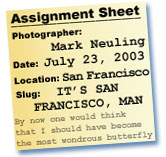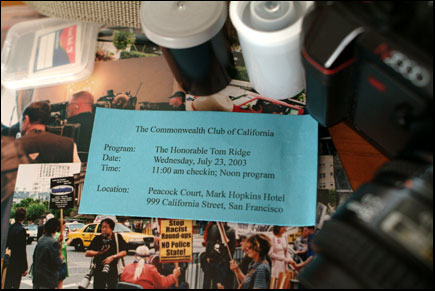IT'S
SAN FRANCISCO, MAN
By Mark Neuling
Field Camera Operator for TechTV
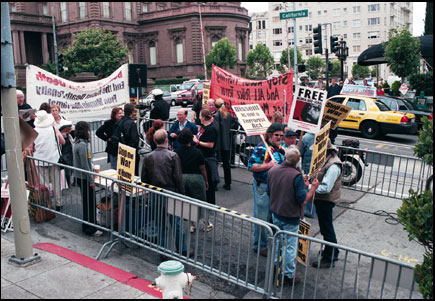
Protesters
gather outside the Mark Hopkins Hotel before a speech
by Homeland Security Secretary Tom Ridge.
San Francisco, California, July 2003.
© 2003 Mark Neuling |
|
The
protesters arrived an hour after we did. Most are wearing
jackets or scarves against the breeze and overcast skies. Occasional
patches of blue do manage to peek through the gray. Hey,
that’s summer in San Francisco. One paper the next
day reports the number of protesters at 200, another says there
were only a couple of dozen. I would concur with the smaller
number. |
They
are here outside the Mark Hopkins Hotel on Knob Hill to protest
a speech
by Homeland Security Secretary Tom Ridge. Most, of the protesters
are well passed middle age. Actually I’m middle-aged,
I’m talking senior citizens here. The tie-dyed
shirts and picket signs belie the gray hair, potbellies and wrinkles. The
San Francisco Police Department has them corralled behind
police barricades, closing down one lane of California St. in
the process. |
Illustration
by Mark Neuling.
© Mark
Neuling 2003
|
|
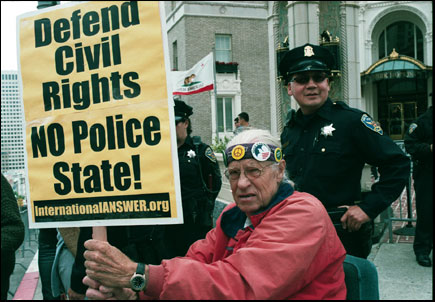
Protesters
and police outside the Mark Hopkins Hotel before a
speech to the Commonwealth Club by Homeland
Security Secretary Tom Ridge. San Francisco, California, July
2003.
© 2003
Mark Neuling |
|
There
are no riot-police here. No helmets, no clubs no paddy wagons. They’re
not needed; just the regular beat cops. The police
let one aged protester remain outside the barricades. He
is in one of those motorized scooters. His gray hair is
wreathed in a bandanna adorned with various buttons espousing
his political beliefs. He smiles benignly for the cameras
of the press, the overcast softening the wrinkles around his
eyes. |
Who
knows what the tourists and hotel guests think of all this.
We had arrived about 45 minutes after the scheduled press check
in. Once
again this was a last minute assignment. The reporter I’m
teamed with apologizes profusely at the desk where the media is to get
credentials. We are the only crew standing there; the others
are already spread about the lobby of the hotel with their coffee and
papers. One of the Secret Service agents overhears our apologies
and says that we will have to go to the “punishment room,” because
of our tardiness. Wow! What do you know, someone from the
Secret Service with a sense of humor? I wisely keep my mouth shut
as he conducts one of the most thorough bag searches I’ve
ever been subject to.
He then turns to the reporter. She has lost her Press Pass. He
asks us if we are together. We both nod silently. He asks
her for some form of picture ID. The search of her bag turns
up an extra lady's undergarment. The reporter was scheduled
to anchor the newscast that evening and she had brought a change
of clothing. “Guess
you guys see everything,” she blushes to the agent. He
lets us in to auditorium where Secretary Ridge’s speech is
to be held. It’s
a big, big room.
Since the speech isn’t to take place for more than two hours we
have plenty of time to kill. I set my camera up on the platform
in the back of the room while the reporter goes for some coffee
and a paper.
Another television photographer from the Fox affiliate in Oakland
and I string cable for our audio feed. We ask one of the hotel’s
audio-visual guys if he will give us a mic check. The audio-visual
tech makes the long walk to the podium and begins his count down. The
audio is screaming on our VU meters. The other shooter and I check
the audio multi-box that we are patched into, everything seems normalized. I
ask the AV tech if he could bring the level down some. He tweaks
something on stage and the level drops. The other shooter asks
him to bring it down even more. Eventually, together, we get
the audio dialed in.
By now the reporter is back with her coffee and papers. She reads
the NY Times and passes the Examiner over to me. The poor
San Francisco Examiner, once the flagship of the Hearst empire,
is
now a free tabloi
At
eleven they open the doors to the public and the media. We
file by the Secret Service agents again; everyone has their
bag or purse checked. All the camera crews stand by their
gear. We compare white balance settings for the light
on the stage. The room has huge windows on the right side;
the sheer curtains do little do to block the weak daylight drifting
through. At least the light is somewhat diffused because
of the overcast outside. One of the TV newspukes notes
that the cut-away shots are going to be blue. They are. |
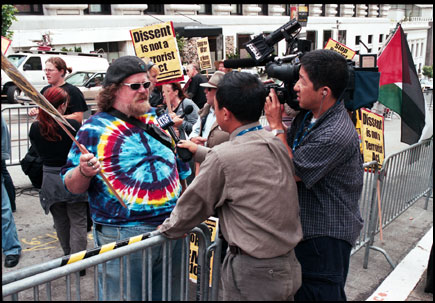
A
television crew from KTSF Channel 26 interviews protesters
in
front of the Mark Hopkins Hotel.
San Francisco, California, July 2003.
© 2003 Mark Neuling |
|
The
reporter I’m with has disappeared again, so I decide
to head outside to get some shots of the protesters. The sides
are pretty evenly matched. The police, media and protesters
are all at about the same strength number wise. It’s
hard to tell where the media representatives end and the protesters
begin. Actually the
media seems to be taking the presence of these folks a whole
lot more seriously than they take of themselves. The protesters
seem to enjoy being interviewed and photographed.
Once back inside again, with some footage of the festivities outside
safely recorded in my camera, I wait. The media too, is fenced
in at the back of the auditorium. The protesters outside behind
police barricades, the media behind velvet ropes. One young newspaper
photographer slumps against the wall besides me. He has a digital
SLR slung over each shoulder. One has the familiar white lens
with the scalloped lens hood. He is terribly under-lensed for
this event, especially since the Press is confined to the back of the
room. I comment on his cameras and ask if he gets a little extra
magnification because they’re digital. “No these are
Canons,” he mourns. A shooter from another paper armed with
Nikons offers to loan him his camera for one shot. “I can
e-mail it to you,” he offers. “Or maybe Eugene can
loan you his gear for a few shots,” says the Nikon shooter. “He
uses Canon equipment.” Competing newspaper photographers
working together.
The gods at this point must have heard the prayers of the still
shooters. A
gentleman with a slight Bronx accent tells them that shortly after Secretary
Ridge begins his speech they will be escorted to the front for a few
minutes so that they can get their shots. You can hear a collective
sigh of relief go up from the print guys. Most stay up front
through out the entire speech.
The television shooters are having a conniption of their own. A
woman, most likely from Secretary Ridge’s staff, informs us that
he will briefly meet with the media afterwards downstairs in the hotel. One
shooter asks if there will be an audio box to patch in to. She
says there won’t be one. “Well some of us don’t
have reporters to hold microphones, how are we suppose to get sound?” gripes
the old hand. “We’re not the Washington press corps
with boom mics,” he chimes. The PR lady nervously smiles
at us from in front of the velvet rope. “How about a podium?” asks
another cameraman. Again the staffer smiles and says the Secretary
prefers not to use a podium. The shooter with the loudest protests
of all sits down in a chair besides his camera and mutters that if he
can't get good sound why should he cover the Secretary’s Q & A
with the media at all. She smiles again and then literally
does a jig in front of us and strides away.
The Secretary takes the stage shortly after noon. After a brief
introduction he reads from his prepared speech, one that has already
been distributed to the media. We already know which sound bites
we’ll be using before we’ve even heard the speech.
While these big events may look exciting to the public on the evening
news, for we TV cameramen and women it’s really pretty dull once
they event is under way. Check the audio levels, vary the framing
a bit, get cut-aways of the audience and of the other TV crews. Mostly
we just
fidget and pray we don't run out of tape at some
crucial point.
After his speech Secretary Ridge answers questions related to homeland
security, Iraq and civil liberties. All in all he’s before
the audience for a little more than an hour. At the conclusion
of his speech the assorted media representatives make a beeline
to a small hallway on a lower level of the hotel.
We form a phalanx of cameras, microphones and reporters bridging
the width of this small space. There are at least five television
crews spread across a hallway no more than eight or nine feet
wide. Mix
in the reporters from TV, print and radio, plus the one or two
brave still photographers and you’d have a pretty good rugby
scrum. In
an understatement, we are literally standing shoulder to shoulder.
Believe it or not this is a slow dance that many of us relish.
Some genius with a TV camera notes that the hallway is dark. Yeah,
that’s why we have these lights screwed on to the top of our cameras. I
ask the reporter I’m with to give me a white balance. She
steps out of the scrum with a white piece of paper and I turn on my
headlight. Other lights snap on. A reporter from Telemundo
holds up his notepad, after a few moments he asks if any one still needs
a white balance. We’re working together.
A photographer from one of the papers is directly to my left. I
try to squeeze over a little to give him some room. He thanks
me for my effort and notes that he’s OK. His lens
is just above my left shoulder, small guys these newspaper shooters.
Homeland Security Secretary Tom Ridge slowly makes his way down
the corridor towards the waiting members of the press. He shakes a
few hands along the way. The TV lights turn on almost in unison. The
microphones are held before the Secretary, he is surprisingly soft-spoken
and articulate. Secret Service agents line the passageway
on either side of the corridor.
The newspaper photographer next to me gently brushes aside the
hair of the reporter I’m with onto the nape of her neck and
out of his frame. My reporter holds the microphone of the cameraman
from the NBC affiliate in San Jose. He is working without a
correspondent and is stuck too far back in the pack to get any
kind of descent sound. Several
other reporters hold more than one microphone. Reporters
and photographers from competing papers, radio and television stations
all working together in order to file their stories and make their
air times. Somehow, when we all work together, it all
works out, that’s San Francisco.
© Mark Neuling 2003
The opinions expressed are solely those of the author.
Email info: markneuling@techtvcorp.com
TechTV is the world’s leading cable and satellite television channel
covering technology news, information, and entertainment from a consumer,
industry, and market perspective 24 hours a day. Available in more
than 75 million households across 70 countries, TechTV is also the world’s
largest producer and distributor of programming about
technology.
Copyright TechTV 2003 TechTV Inc. All rights reserved.
|
